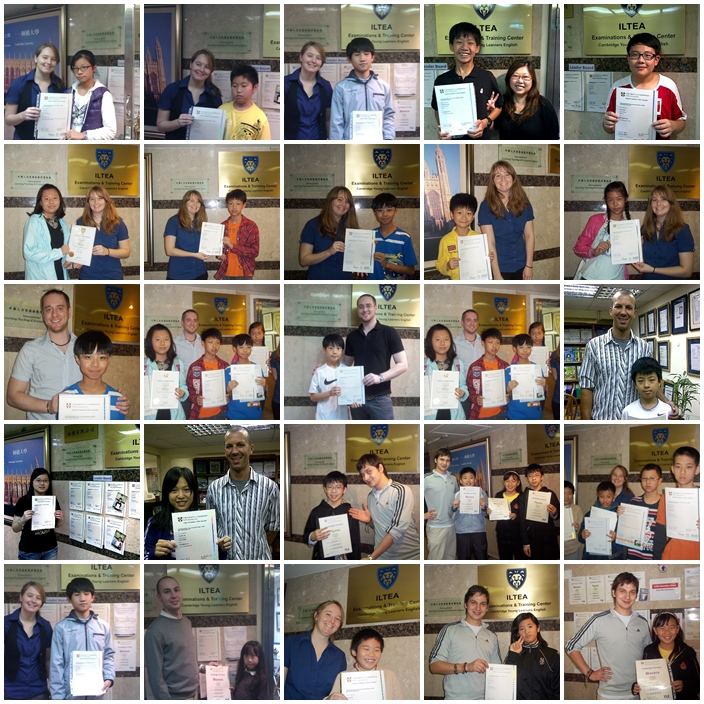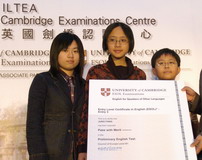|
|
 |
| KET 劍橋初級英語認證 Key English Test 考試簡介 |
 |
KET 與CEF 級數對照表
KET 考試結構
KET 第一節 閱續寫作測驗
KET 第二節 聽力測驗
KET 第三節 口試
KET 考試範圍
KET 考試用書
|
 |
|
KET 與 CEF 之對照表
CEF
|
Main Suite |
ILTEA |
GEPT |
| C2 |
CPE |
C2 |
優級 |
| C1 |
CAE |
C1 |
高級 |
| B2 |
FCE |
B2 |
中高級 |
| B1 |
PET |
B1 |
中級 |
| A2 |
KET |
A2
Level 3 |
初級 |
| A1 |
|
Level 2
Level 1 |
|
|
#劍橋KET合格英語證書與教育部採認之「歐洲語言學習、教學、評量共同參考架構」(CEF) 之 A2級 直接對照,並列載明於證書上。
KET 有3個考試科目(3 papers), 包含了4項語言能力檢測 。第一科為閱讀和寫作部分佔總分50% , 第二科為聽力測驗佔25% , 第三科為 口試佔25% 。 考試題材則包括了個人資料 、 住家與居住環境 、個人的感覺、 意見 、 經驗 、 每天的生活 、嗜好、 運動 、 休閒活動 、社交、 旅遊 、 假日 、 健康 、 購物 、服裝、 飲食 、 公共設施如郵局 , 銀行 , 警察局等 、 場所和建築物 、 語言 、 天氣 。
|
|
考試結構
考試項目
|
測驗部分及內容 |
題數 |
測驗時間 |
第一節
Reading & Writing |
Part 1: Matching 配對題
|
5 |
1小時10分鐘
共56題 |
Part 2: Multiple choice 選擇題
|
5 |
| Part 3: Multiple choice & Matching 選擇及配對題 |
10 |
| Part 4: Multiple choice 選擇題 |
7 |
| Part 5: Multiple choice cloze 克漏字選擇題 |
8 |
Part 6: Word completion 克漏字填充題 |
5 |
| Part 7: Open cloze 填充題 |
10 |
Part 8: Information transfer 訊息轉換 |
5 |
Part 9: Continuous writing 短篇寫作 |
1 |
第二節
Listening |
Part 1: Multiple choice 選擇題 |
5 |
30分鐘
共25題 |
| Part 2: Matching 配合題 |
5 |
| Part 3: Multiple choice 選擇題 |
5 |
Part 4: Gap-fill 填充題 |
5 |
Part 5: Gap-fill 填充題 |
5 |
第三節
Speaking
面試時間或日期得由認證中心另訂之 |
Part 1: Each candidate interacts with examiner
考生與考官間個人基本資料問答 |
5-6分鐘 |
8-10分鐘
|
Part 2: Candidates interact with each other兩位考生針對提示卡的內容相互問答 |
3-4分鐘 |
|
考生會在檢定後 6至8週收到成績單。 KET 的成績是3科測驗 -- 閱讀和寫作 、 聽力 、 口試 -- 的總和 。考生的強項和弱項都會載明再成績單上。成績合格 的考生將在考試後 10至12週收到證書,通過的等級會記載在證書上。 KET 有兩種通過等級:
KET has two passing grades (劍橋初級英語認證2010年通過率約為78.7%):
Pass with Distinction (答對95%)
Pass with Merit (答對85%)
Pass (答對70%)
and two failing grades:
Narrow Fail (65%-69%)
Fail (65%以下)
The overall pass rate for the December 2004 examination was 78.7 % of the candidates. The minimum successful performance which a candidate typically requires in order to achieve a ‘Pass' grade corresponds to about 70% of the total marks. ‘Pass with Merit' corresponds to approximately 85% of the total marks available. A ‘Narrow Fail' grade means that the candidate is within 5% of the ‘Pass' level.
Statements of results contain a graphical display of a candidate's performance in eachpaper. These are shown against a scale of Exceptional – Good – Borderline – Weak and indicate the candidate's relative performance in each paper.
|
 Reading/Writing 閱讀寫作〈1小時10分鐘〉 Reading/Writing 閱讀寫作〈1小時10分鐘〉
|
Part 1
選擇題 / 配對題
標示閱讀: 5題3選1選擇題,5題配對題
In Part 1, candidates are tested on their ability to understand the main message of a sign, notice or other very short text. These texts are of the type usually found on roads, in railway stations, airports, shops, restaurants, offices, schools, etc.
Wherever possible these texts are authentic and so may contain lexis which is unfamiliar to the candidates, but this should not prevent them from understanding the main message. This is a matching question, requiring candidates to match five sentences to the appropriate sign or notice.
|
| |
Part 2
選擇題
單字定義: 8選5選擇題
In Part 2, candidates are tested on their knowledge of vocabulary. They are asked to fill the gap in each of five sentences with one of the three options provided. There is a completed example sentence at the beginning. The six sentences are all on the same topic or are linked by a simple story line.
Candidates should deal with each sentence individually but be aware that the overall context will help them find the correct answer.
|
| |
Part 3
選擇題 / 配對題
日常會話: 5題3選1選擇題,5題配對題
In Part 3, candidates are tested on their ability to understand the language of the routine transactions of daily life.
Questions 1–15 are multiple-choice (3 options). Candidates are asked to complete five short conversational exchanges.
Questions 16–20 are matching exercises. Candidates are asked to complete a longer dialogue, by choosing from a list of eight options. These dialogues take place in shops, hotels, restaurants, etc., and in various work, study and social situations.
|
| |
Part 4
選擇題
主題與細節: 5題3選1選擇題
In Part 4, candidates are tested on their ability to understand the main ideas and some details of longer texts (about 230 words). These texts come from authentic sources, such as newspaper and magazine articles, but are adapted to make them accessible to candidates. Texts may include vocabulary which is unfamiliar to the candidates, but this should not interfere with their ability to complete the task.
The questions in this part may be multiple-choice comprehension questions (with 3 options). Alternatively, candidates may be asked to decide whether, according to the text, each one of a set of statements is correct or incorrect, or whether there is insufficient information in the text to decide this.
|
| |
Part 5
選擇題
辨認關鍵字: 8題3選1克漏字
In Part 5, candidates are tested on their knowledge of grammatical structure and usage in the context of a reading text. As with Part 4, texts are adapted from newspaper and magazine articles, encyclopedia and other authentic sources.
Words are deleted from the text and candidates are asked to complete the text by choosing the appropriate word from 3 options. Deletions mainly focus on structural elements, such as verb forms, determiners, pronouns, prepositions and conjunctions. Understanding of structural relationships at the phrase, clause, sentence or paragraph level is also required.
|
| |
Part 6
克漏字填充題
Parts 6–9 focus particularly on writing. Part 6-9 屬於寫作能力測驗
便條、短箋與信件
In Part 6, candidates are asked to produce five items of vocabulary and to spell them correctly. The five items of vocabulary will all belong to the same lexical field, for
example jobs, food, things you can find in a house, etc. For each word they have to write, candidates are given a ‘definition' of the type you can find in a learner's dictionary, followed by the first letter of the required word and a set of dashes to represent the number of the remaining letters in the required word. There is a completed example at the beginning.
|
| |
Part 7
表格填寫
閱讀與填寫表格
In Part 7, candidates are asked to complete a gapped text.
Texts are short and simple and are of the type candidates at this level may be expected to write, for example notes and short letters. A text may take the form of a note plus a reply to that note, or may be a single letter. Deletions in the text focus on grammatical structure and vocabulary. Candidates are only asked to produce words which students at this level can be expected to actively use. Correct spelling of the missing words is essential in this part.
|
| |
Part 8 訊息轉換
閱讀及訊息傳遞
In Part 8, candidates complete a simple information transfer task. They are asked to use the information in one or two short texts (note, e-mail, advertisement, etc.) to complete aform, notice, diary entry or other similar type of document.
Candidates have to understand the text(s) in order to complete the task, and the focus is on both writing and reading ability. Candidates are expected to understand the vocabulary commonly associated with forms, for example surname, date of birth, etc. The required written production is at word and phrase level, not sentence level. Correct spelling and use of capital letters is essential in this part.
|
| |
Part 9 – 20-25字的寫作
短文書寫,如寫張明信片或賀卡給朋友
In Part 9, candidates are given the opportunity to show that they can communicate a written message (25–35 words) of an authentic type, for example a note or postcard to a friend.
The instructions indicate the type of message required, who it is for and what kind of information should be included.
Candidates must respond to the prompts in all three bullet points. All must be addressed in order to complete the task fully. Alternatively, the candidates may be asked to read and respond appropriately to three elements contained within a short note from a friend.
|
| |
|
| |
|
 Listening 聽 力〈30分鐘〉 Listening 聽 力〈30分鐘〉
|
Part 1 選擇題
5段簡短對話,5題3選1選擇題
In Part 1, candidates are tested on their ability to identify simple factual information in five separate short conversational exchanges. The short conversations are either between friends or relatives, or between a member of the public and a shop assistant, booking office clerk, etc. The information focused on in these dialogues is, for example, prices, numbers, times, dates, locations, directions, shapes, sizes, weather, descriptions of people and current actions.
On the question paper, the candidates see a simple question and three multiple-choice options based on pictures or drawings. There are five questions in Part 1.
|
|
Part 2 配對題
日常會話, 5題配對題
In Part 2, candidates are tested on their ability to identify simple factual information in a longer conversation. The conversation is an informal one between two people who know each other. The topic will be one of personal interest to the speakers, for example daily life, travel, occupational activities, free time activities, etc.
Candidates show their understanding of the conversation by matching two lists of items, for example people with the food they like to eat, or days of the week with activities.
|
| |
Part 3 選擇題
日常會話, 5題3選1選擇題
In Part 3, candidates are also tested on their ability to identify simple factual information. The listening text is usually an informal conversation between two people who know each other about a topic of personal interest to the speakers. It is sometimes a transactional exchange, e.g. a person making enquiries in a travel agent's.
In this part, candidates show their understanding of the conversation by answering five multiple-choice questions, each with three options. |
| |
Parts 4 and 5
填充題
日常會話,填文字或數字 共10題
In Parts 4 and 5, candidates are tested on their ability to extract specific factual information from a dialogue or monologue and write it down. The dialogue or monologue is in an informal or a neutral context, for example in shops, offices, etc. A monologue may be a recorded message. The information to be extracted is of a practical nature, for example opening times, entrance fees, etc.
Candidates are asked to complete a memo, message or notes on the question paper by extracting information from the listening text and writing it down. Information to be writtendown consists of numbers, times, dates, prices, spellings and words. In each case, candidates are required to write down one or two words or numbers. Completely accurate spelling is not required, except where a name has been spelt out in the listening text or when it is a simple high-frequency word.
|
| |
|
| |
|
 Speaking口語能力〈8~10分鐘〉 Speaking口語能力〈8~10分鐘〉
|
Part 1
由口試考官詢問應試者個人資料
This takes 5 to 6 minutes. In this part, each candidate interacts with the interlocutor, using the language normally associated with meeting people for the first time, giving factual information of a personal kind, for example name, place of origin, occupation, family, etc. Candidates are also expected to be able to talk about their daily life, interests,likes, etc.
Candidates should be able to respond appropriately to questions asking for simple information about themselves. They should, for example, be able to give their name (including spelling it), country of origin, job or subject of study, give information about their family, home town, school, free time activities and talk simply about their likes and dislikes.
|
| |
Part 2
由二至三位考生相互針對提示卡的提問題並由對方回答
This takes 3 to 4 minutes. In this part, the two candidates interact with each other. This involves asking and answering questions about factual information of a non-personal kind. Prompt cards are used to stimulate questions and answers which will be related to daily life, leisure activities and social life (including references to places, times, services, where to go, how to get there, what to eat, etc.).
Simple role plays in which students are required to ask and answer questions will provide useful practice. Such role plays should focus on everyday language and situations and involve questions about daily activities and familiar experiences, or feature exchanging information about such things as charges and opening times of, for example, a local sports centre.
|
| |
下載口試樣題
|
| |
|
 考試範圍 考試範圍
|
|
| |
Inventory of Grammatical Areas
Verbs
regular and irregular forms
Modals
can (ability; requests; permission)
could (ability; polite requests)
would (polite requests)
will (future)
shall (suggestion; offer)
should (advice)
may (possibility)
have (got) to (obligation)
must (obligation)
mustn't (prohibition)
need (necessity)
needn't (lack of necessity)
Tenses
Present simple: states, habits, systems, processes and with future meaning (and verbs not used in the continuous form)
Present continuous: present actions and future meaning
Present perfect simple: recent past with just, indefinite past with yet, already, never, ever; unfinished past with for and since
Past simple: past events
Past continuous: parallel past actions, continuous actions interrupted by the past simple tense
Future with going to
Future with will and shall: offers, promises, predictions, etc.
Verb Forms
Affirmative, interrogative, negative
Imperatives
Infinitives (with and without to) after verbs and adjectives
Gerunds (-ing form) after verbs and prepositions
Gerunds as subjects and objects
Passive forms: present and past simple
Short questions (Can you?) and answers (No, he doesn't)
Clause types
Main clause: Carlos is Spanish.
Co-ordinate clause: Carlos is Spanish and his wife is English.
Subordinate clause following sure, certain: I'm sure (that)
she's a doctor.
Subordinate clause following know, think, believe, hope:
I hope you're well.
Subordinate clause following say, tell: She says (that) she's his sister.
Subordinate clause following if, when, where, because:
I'll leave if you do that again.
He'll come when you call.
He'll follow where you go.
I came because you asked me.
Interrogatives
What, What (+ noun)
Where; When
Who; Whose; Which
How; How much; How many; How often; How long; etc.
Why
(including the interrogative forms of all tenses and modals listed)
Nouns
Singular and plural (regular and irregular forms)
Countable and uncountable nouns with some and any
Abstract nouns
Compound nouns
Noun phrases
Genitive: ‘s & s'
Double genitive: a friend of theirs
Pronouns
Personal (subject, object, possessive)
Impersonal: it, there
Demonstrative: this, that, these, those
Quantitative: one, something, everybody, etc.
Indefinite: some, any, something, one, etc.
Relative: who, which, that
Determiners
a + countable nouns
the + countable/uncountable nouns
Adjectives
Colour, size, shape, quality, nationality
Predicative and attributive
Cardinal and ordinal numbers
Possessive: my, your, his, her, etc.
Demonstrative: this, that, these, those
Quantitative: some, any, many, much, a few, a lot of, all, other, every, etc.
Comparative and superlative forms (regular and irregular)
Order of adjectives
Participles as adjectives
Adverbs
Regular and irregular forms
Manner: quickly, carefully, etc.
Frequency: often, never, twice a day, etc.
Definite time: now, last week, etc.
Indefinite time: already, just, yet, etc.
Degree: very, too, rather, etc.
Place: here, there, etc.
Direction: left, right, etc.
Sequence: first, next, etc.
Pre-verbal, post-verbal and end-position adverbs
Comparative and superlative forms (regular and irregular)
Prepositions
Location: to, on, inside, next to, at (home), etc.
Time: at, on, in, during, etc.
Direction: to, into, out of, from, etc.
Instrument: by, with
Miscellaneous: like, about, etc.
Prepositional phrases: at the end of, in front of, etc.
Prepositions preceding nouns and adjectives: by car, for sale, on holiday, etc.
Connectives
and, but, or,
when, where, because, if
Note that, in KET, students will meet forms other than those listed above on which they will not be directly tested.
|
| |
Topics
Personal identification
Personal feelings, opinions and experiences
Hobbies and leisure
Sport
Travel and holidays
Transport
Health, medicine and exercise
Shopping
Clothes
Services
Language
House and home
Daily life
Entertainment and media
Social interaction
School and study
Food and drink
People
Places and buildings
Weather
The natural world
Work and jobs
|
| |
Lexis
The Vocabulary used in KET is restricted to common items
which normally occur in the everyday vocabulary of native
speakers using English today.
Candidates should know the lexis appropriate to their
personal requirements, for example nationalities, hobbies,
likes and dislikes.
Note that the use of American pronunciation, spelling and lexis is acceptable in KET.
|
|
| |
|
|
| All rights reserved, 2012©
ILTEA Examinations Centre |
|

